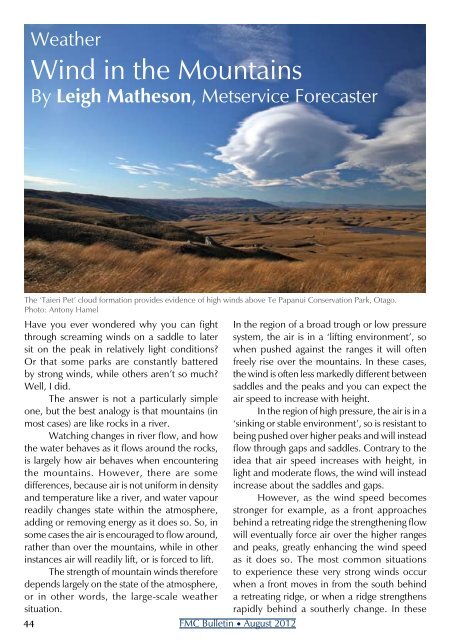August 2012 Issue - Federated Mountain Clubs of NZ
August 2012 Issue - Federated Mountain Clubs of NZ
August 2012 Issue - Federated Mountain Clubs of NZ
You also want an ePaper? Increase the reach of your titles
YUMPU automatically turns print PDFs into web optimized ePapers that Google loves.
WeatherWind in the <strong>Mountain</strong>sBy Leigh Matheson, Metservice ForecasterThe ‘Taieri Pet’ cloud formation provides evidence <strong>of</strong> high winds above Te Papanui Conservation Park, Otago.Photo: Antony HamelHave you ever wondered why you can fightthrough screaming winds on a saddle to latersit on the peak in relatively light conditions?Or that some parks are constantly batteredby strong winds, while others aren’t so much?Well, I did.The answer is not a particularly simpleone, but the best analogy is that mountains (inmost cases) are like rocks in a river.Watching changes in river flow, and howthe water behaves as it flows around the rocks,is largely how air behaves when encounteringthe mountains. However, there are somedifferences, because air is not uniform in densityand temperature like a river, and water vapourreadily changes state within the atmosphere,adding or removing energy as it does so. So, insome cases the air is encouraged to flow around,rather than over the mountains, while in otherinstances air will readily lift, or is forced to lift.The strength <strong>of</strong> mountain winds thereforedepends largely on the state <strong>of</strong> the atmosphere,or in other words, the large-scale weathersituation.44In the region <strong>of</strong> a broad trough or low pressuresystem, the air is in a ‘lifting environment’, sowhen pushed against the ranges it will <strong>of</strong>tenfreely rise over the mountains. In these cases,the wind is <strong>of</strong>ten less markedly different betweensaddles and the peaks and you can expect theair speed to increase with height.In the region <strong>of</strong> high pressure, the air is in a‘sinking or stable environment’, so is resistant tobeing pushed over higher peaks and will insteadflow through gaps and saddles. Contrary to theidea that air speed increases with height, inlight and moderate flows, the wind will insteadincrease about the saddles and gaps.However, as the wind speed becomesstronger for example, as a front approachesbehind a retreating ridge the strengthening flowwill eventually force air over the higher rangesand peaks, greatly enhancing the wind speedas it does so. The most common situationsto experience these very strong winds occurwhen a front moves in from the south behinda retreating ridge, or when a ridge strengthensrapidly behind a southerly change. In theseFMC Bulletin • <strong>August</strong> <strong>2012</strong>






